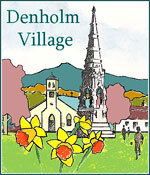The other important industry of the 19th century [other from the Stocking Industry] was the quarrying at Denholm Hill, or quarry knowes, about a mile south of the village on the lower slopes of Ruberslaw.
Local builders, notably the Ferguson's and the Littles, had quarried there for some time but only for their own use.
PHOTO: Stone from the Quarries being transported through Denholm to Hassendean Station
In 1818 Walter Laing, farmer at Denholm Hill, opened the quarries as a business. The Eastern or white quarry was opened first. Both it and the ruins of the old quarry cottages can still be seen. Later the red quarry was opened, to the west of the farmhouse and steading. Denholm Hill stone was used for the Duke of Buccleuchs mansion at Bowhill and this helped to make its reputation. For the next half-century it was in great demand. In 1868 in 'Denholm and its vicinity' Sir Walter Elliot writes that "Mr Laing (son of the founder) supplies the whole district with building material of the best description."
At 6am when the hewers arrived for work there might be 60 carts waiting to be loaded, coming from as far away as Galashiels and Selkirk. They used to cross the Teviot at the Ford at the bottom of the Canongate in order to get to Hassendean station which opened in 1849. When the river was high they had to make a long detour by the bridge at Hornshole. This continued until 1864 when the present Teviot road bridge was built to connect with a new road to Hassendean station.
Denholm Stone is sandstone (the local rock is Devonian old red sandstone). It is softer than the very hard whinstone much used in Hawick and the upper Teviot Valley and was therefore more easily worked into the blocks needed for lintels and flagstones. Most of the older houses in Denholm are built of it, both red and white ( i.e. buff). Also Cavers House which was substantially rebuilt in the late 18th century.
Builders uplifting stone from the quarry were charged 9d per cart load of selected rubble, 6d for rough rubble and 4d if it was to be used on the Cavers estate. Rubble carted to Denholm would have cost 1/3d per ton. Hewers wages were 12s per week but later rose to 20s.
As the Laing's of Denholm Hill were tenants of the Cavers estate, the Laird stood to benefit from the success of the quarries and consequently feuars were offered better feus in Denholm if they would work in the quarries. The census of 1861 records 55 masons (i e quarrymen) but we are also told that as many as 200 men worked at the quarries if a big job was in hand. Many of the workers would be migrant, some of them Irish, and quite a number stayed in lodging houses in the Cannon Gate. Few quarry men survived beyond middle age due to lung disease caused by the stone dust.
The seam of rock was originally close to the surface but in time it became very deep and hard to work. The quarrying was made even more difficult and expensive by the increasing amount of boulder clay covering the rock. With the rising cost of carriage to the railway at Hassendean the business became less and less profitable. The coming of the railway made other quarries more accessible and the price of Denholm Hill stone became uncompetitive. Mr Laing finally close them in the late 1870's. The Little family worked them for a time about 1880 followed by Robert Oliver of the Post Office and Rule Tait of Rillbank. A small whinstone quarry on the southern edge of Denholm Hill Wood was also worked in the late 19th century.

